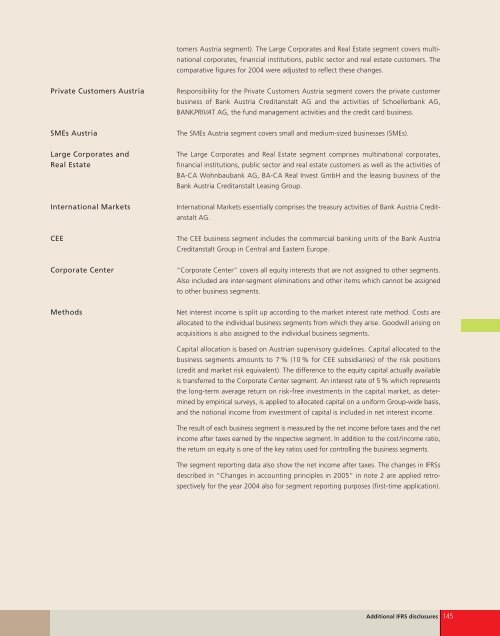team spirit - Bankier.pl
team spirit - Bankier.pl
team spirit - Bankier.pl
You also want an ePaper? Increase the reach of your titles
YUMPU automatically turns print PDFs into web optimized ePapers that Google loves.
Private Customers Austria<br />
SMEs Austria<br />
Large Corporates and<br />
Real Estate<br />
International Markets<br />
CEE<br />
Corporate Center<br />
Methods<br />
tomers Austria segment). The Large Corporates and Real Estate segment covers multinational<br />
corporates, financial institutions, public sector and real estate customers. The<br />
comparative figures for 2004 were adjusted to reflect these changes.<br />
Responsibility for the Private Customers Austria segment covers the private customer<br />
business of Bank Austria Creditanstalt AG and the activities of Schoellerbank AG,<br />
BANKPRIVAT AG, the fund management activities and the credit card business.<br />
The SMEs Austria segment covers small and medium-sized businesses (SMEs).<br />
The Large Corporates and Real Estate segment comprises multinational corporates,<br />
financial institutions, public sector and real estate customers as well as the activities of<br />
BA-CA Wohnbaubank AG, BA-CA Real Invest GmbH and the leasing business of the<br />
Bank Austria Creditanstalt Leasing Group.<br />
International Markets essentially comprises the treasury activities of Bank Austria Creditanstalt<br />
AG.<br />
The CEE business segment includes the commercial banking units of the Bank Austria<br />
Creditanstalt Group in Central and Eastern Europe.<br />
“Corporate Center” covers all equity interests that are not assigned to other segments.<br />
Also included are inter-segment eliminations and other items which cannot be assigned<br />
to other business segments.<br />
Net interest income is s<strong>pl</strong>it up according to the market interest rate method. Costs are<br />
allocated to the individual business segments from which they arise. Goodwill arising on<br />
acquisitions is also assigned to the individual business segments.<br />
Capital allocation is based on Austrian supervisory guidelines. Capital allocated to the<br />
business segments amounts to 7 % (10 % for CEE subsidiaries) of the risk positions<br />
(credit and market risk equivalent). The difference to the equity capital actually available<br />
is transferred to the Corporate Center segment. An interest rate of 5 % which represents<br />
the long-term average return on risk-free investments in the capital market, as determined<br />
by empirical surveys, is ap<strong>pl</strong>ied to allocated capital on a uniform Group-wide basis,<br />
and the notional income from investment of capital is included in net interest income.<br />
The result of each business segment is measured by the net income before taxes and the net<br />
income after taxes earned by the respective segment. In addition to the cost/income ratio,<br />
the return on equity is one of the key ratios used for controlling the business segments.<br />
The segment reporting data also show the net income after taxes. The changes in IFRSs<br />
described in “Changes in accounting princi<strong>pl</strong>es in 2005” in note 2 are ap<strong>pl</strong>ied retrospectively<br />
for the year 2004 also for segment reporting purposes (first-time ap<strong>pl</strong>ication).<br />
Additional IFRS disclosures 145
















